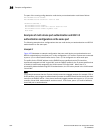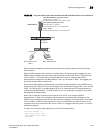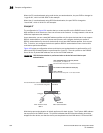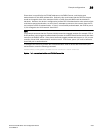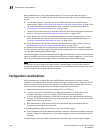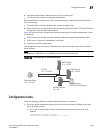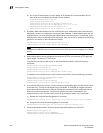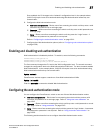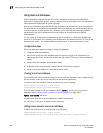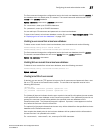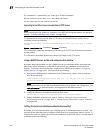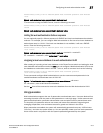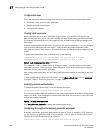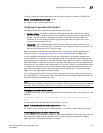
1310 PowerConnect B-Series FCX Configuration Guide
53-1002266-01
Configuration tasks
37
• On a Layer 3 PowerConnect switch, assign an IP address to a virtual interface (VE) for
each VLAN on which Web Authentication will be enabled.
PowerConnect#configure terminal
PowerConnect(config)#vlan 10
PowerConnect(config-vlan-10)#router-interface ve1
PowerConnect(config-vlan-10)#untagged e 1/1/1 to 1/1/10
PowerConnect(config-vlan-10)#interface ve1
PowerConnect(config-vif-1)#ip address 1.1.2.1/24
2. By default, Web Authentication will use a RADIUS server to authenticate host usernames and
passwords, unless it is configured to use a local user database. If Web Authentication will use
a RADIUS server, you must configure the RADIUS server and other servers. For example, if your
RADIUS server has an IP address of 192.168.1.253, then use the CLI to configure the following
global CLI commands on the PowerConnect switch.
PowerConnect(config)# radius-server host 10.1.1.8
PowerConnect(config)# radius-server key $GSig@U\
NOTE
Remember the RADIUS key you entered. You will need this key when you configure your RADIUS
server.
3. Web authentication can be configured to use secure (HTTPS) or non-secure (HTTP) login and
logout pages. By default, HTTPS is used.
To enable the non-secure Web server on the PowerConnect switch, enter the following
command.
PowerConnect(config)# web-management HTTP
PowerConnect(config)#vlan 10
PowerConnect(config-vlan-10)webauth
PowerConnect(config-vlan-10-webauth)#no secure-login
To enable the secure Web server on the PowerConnect switch, enter the following command.
PowerConnect(config)# web-management HTTPS
PowerConnect(config)#vlan 10
PowerConnect(config-vlan-10)webauth
PowerConnect(config-vlan-10-webauth)#secure-login
4. If the secure Web server is used, in order to access a secure Web page, the Web server needs
to provide a key. This key is exchanged using a certificate. A certificate is a digital document
that is issued by a trusted source that can validate the authenticity of the certificate and the
Web server that is presenting it. Therefore the switch must have a certificate for web
authentication to work. There are two choices for providing the switch with a certificate:
• Upload one using the following global CLI command.
PowerConnect(config)# ip ssl private-key-file tftp <ip-addr> <key-filename>
• Generate one using the following global CLI command.
PowerConnect(config)#crypto-ssl certificate generate default_cert
5. Create a Web Authentication VLAN and enable Web Authentication on that VLAN.
PowerConnect(config)#vlan 10
PowerConnect(config-vlan-10)#webauth
PowerConnect(config-vlan-10-webauth)#enable



